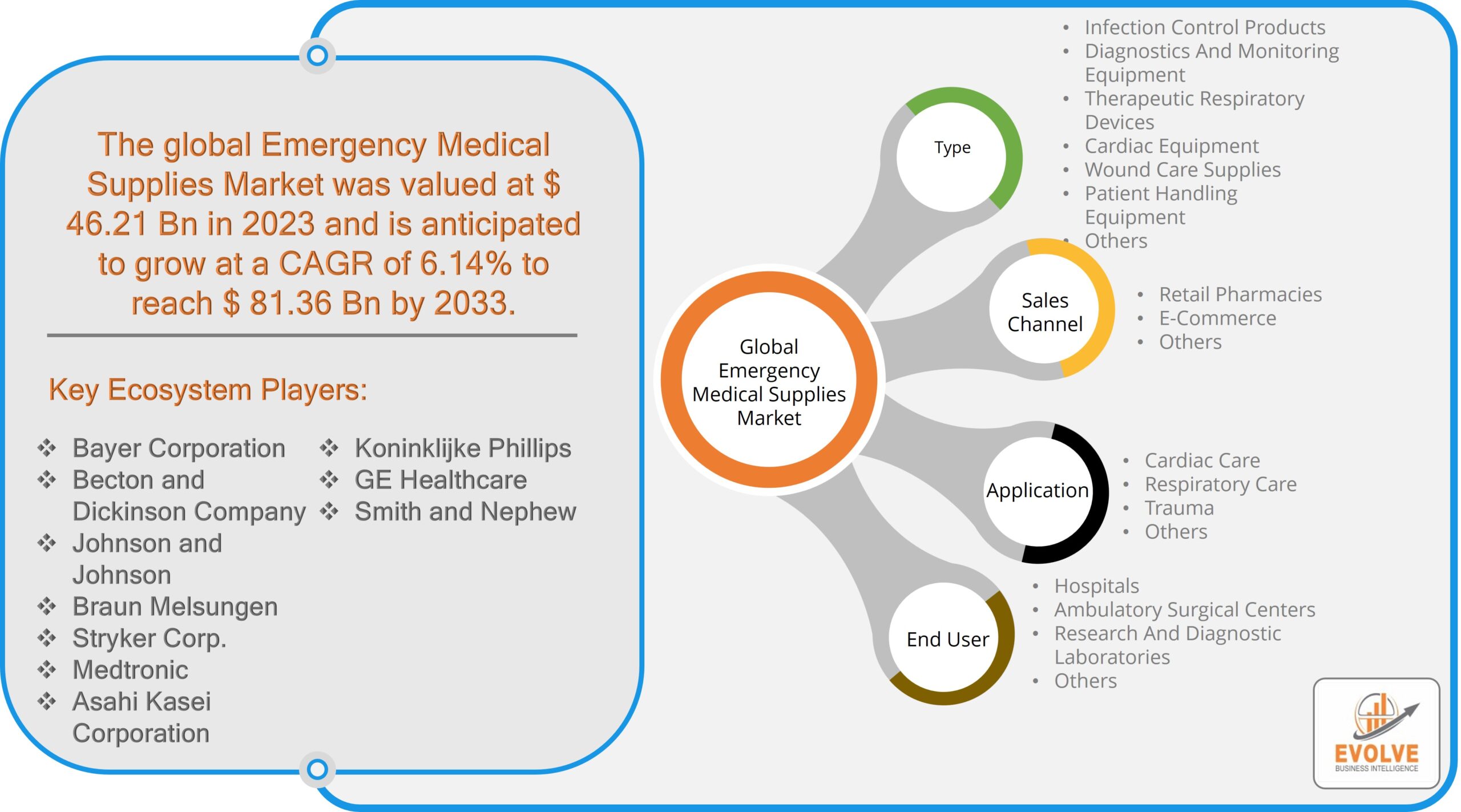Emergency Medical Supplies Market Is Estimated To Record a CAGR of Around 6.14%

Evolve Business Intelligence has published a research report on the Global Emergency Medical Supplies Market, 2023–2033. The global Emergency Medical Supplies Market is projected to exhibit a CAGR of around 6.14% during the forecast period of 2023 to 2033.
Evolve Business Intelligence has recognized the following companies as the key players in the global Emergency Medical Supplies Market: Bayer Corporation, Becton and Dickinson Company, Johnson and Johnson, Braun Melsungen, Stryker Corp., Medtronic, Asahi Kasei Corporation, Koninklijke Phillips, GE Healthcare and Smith and Nephew.
For More Information: https://evolvebi.com/report/emergency-medical-supplies-market-analysis/
Emergency Medical Supplies Market Highlights
The Global Emergency Medical Supplies Market is projected to be valued at USD 81.36 Billion by 2033, recording a CAGR of around 6.14% during the forecast period. The Emergency Medical Supplies Market refers to the sector involved in the production, distribution, and sale of medical products and equipment designed for use in emergency situations. This market encompasses a wide range of supplies that are crucial for the immediate response and treatment of injuries and medical conditions during emergencies.
The market is driven by factors such as increasing awareness about emergency preparedness, rising incidences of accidents and natural disasters, and advancements in medical technology. It caters to various end-users including hospitals, ambulances, emergency response teams, and individual consumers.
The COVID-19 pandemic significantly impacted the Emergency Medical Supplies Market. There was a dramatic increase in demand for various emergency medical supplies, particularly personal protective equipment (PPE) like masks, gloves, gowns, and face shields. Hospitals, healthcare workers, and frontline responders needed these supplies in unprecedented quantities to manage the influx of COVID-19 patients and prevent the spread of the virus. The pandemic caused significant disruptions in global supply chains. Lockdowns, restrictions, and logistical challenges affected the production and distribution of emergency medical supplies. This led to shortages and delays in delivering essential items to where they were most needed. The high demand and limited supply resulted in price spikes for many medical supplies. This volatility impacted both procurement costs for healthcare facilities and affordability for consumers. The pandemic highlighted the importance of emergency preparedness and resilience in healthcare systems. As a result, there has been a heightened focus on building stockpiles, improving supply chain management, and investing in emergency medical infrastructure.
Segmental Analysis
The global Emergency Medical Supplies Market has been segmented based on Type, Application, End User and Sales Channel.
Based on Type, the Emergency Medical Supplies Market is segmented into Infection Control Products, Diagnostics And Monitoring Equipment, Therapeutic Respiratory Devices, Cardiac Equipment, Wound Care Supplies, Patient Handling Equipment and Others. The Therapeutic Respiratory Devices segment is anticipated to dominate the market.
Based on Application, the Emergency Medical Supplies Market is segmented into Cardiac Care, Respiratory Care, Trauma and Others. The Cardiac Care segment is anticipated to dominate the market.
Based on End User, the Emergency Medical Supplies Market is segmented into Hospitals, Ambulatory Surgical Centers, Research And Diagnostic Laboratories and Others. The Hospitals segment is anticipated to dominate the market.
Based on Sales Channel, the global Emergency Medical Supplies Market has been divided into Retail Pharmacies, E-Commerce and Others. The Retail Pharmacies segment is anticipated to dominate the market.
For More Information: https://evolvebi.com/report/emergency-medical-supplies-market-analysis/
Regional Analysis
The Emergency Medical Supplies Market is divided into five regions: North America, Europe, Asia-Pacific, South America, and the Middle East, & Africa. In North America region, advanced healthcare infrastructure, high demand for cutting-edge medical technologies, and significant government and institutional investments. Growth in telemedicine, smart medical devices, and innovations in PPE. Strong focus on preparedness and resilience due to the high frequency of natural disasters and health emergencies. In Europe region, Demand for advanced emergency medical supplies, especially in response to health crises and natural disasters. Innovation in medical technology and PPE. In Asia-Pacific region, rapidly growing healthcare markets, increasing investment in healthcare infrastructure, and rising awareness of emergency preparedness. Expanding market due to increasing healthcare investments and population growth. Significant demand for affordable and accessible emergency medical supplies. In Latin America region, Developing healthcare infrastructure with varying levels of emergency preparedness. Increasing focus on improving healthcare services. Growing demand for emergency medical supplies driven by health emergencies and natural disasters. Potential for market expansion and investments in healthcare infrastructure. In Middle East and Africa region, diverse healthcare markets with varying levels of infrastructure development and emergency preparedness. Increased focus on improving healthcare services and emergency response capabilities.


